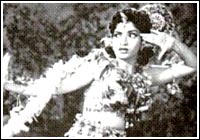
HOME | MOVIES | FEEDBACK |

Dinesh Raheja
V Shantaram's colourful Navrang [1959], marked a hat-trick of successes, coming on the heels of the super successful musical Jhanak Jhanak Payal Baaje [1955], and the tale of prisoner reform Do Aankhen Barah Haath [1957].
Navrang begins with a direct communique by a director to his audience. In his brief but telling address, Shantaram lends credence to the rumours that he nearly lost his sight in an accident on the sets of his last venture, Do Aankhen Barah Haath. An eternal optimist, Shantaram reveals that during that temporary blindness, he saw some hitherto unseen colours of life.
The riotously colourful Navrang is the creative realisation of that experience.
The film's performances border on the theatrical and its sets are pastry pink. Yet Navrang is a must see thanks to its unusual thematic premise and C Ramchandra's unforgettable score set to Bharat Vyas' lyrics. Shantaram takes pains to communicate G D Madgulkar's difficult premise to the audience in a lucid manner. And succeeds.
Married to a beautiful but domesticated woman, a poet creates a more glamorous image of her and starts relating to this fantasy. And Mohini [one who enamours] becomes the muse he seeks inspiration from. Unable to comprehend her husband's flights of fancy, the wife is perturbed by the mystery woman in her husband's life. Eventually, the film which has dichotomised the muse and the reality, fuses them at the end.
The pre-Independence period enhances the film's setting. Navrang opens with an English signboard John and Sons replacing a Hindi one, succinctly symbolising the colonisation of India by the British. A bedraggled old man defies the daunting soldiers and sings, Maati sabhi ki kahani kahegi. The film takes us into a flashback to the days of his youth.
Divakar (Mahipal) is enraptured by his down-to-earth wife Jamuna (Sandhya). Unable to reconcile to Diwakar's desire to live in a world of fantasy, Jamuna disapproves of his ornate poetry. She fails to share Diwakar's vision of her as a sensuous woman and stymies his desire to bridge the gap between the reality and fantasy.
This fans the slightly fanciful Diwakar's quest for his Mohini --- his inspiring muse --- and he creates a fantasy woman in his wife's image.
Soon, Diwakar becomes a recognised poet patronised by the local royalty. Jamuna delivers a baby boy. But their happiness is shortlived. Diwakar loses his job after he full-throatedly sings an inflammatory song against the British. His honest admission of a platonic friendship with courtesan Manjiri, and his inability to provide for his ailing father and starving son, evoke the pragmatic Jamuna's wrath. Jamuna would have probably suffered these husbandly lapses, but she is unable to come to terms with Diwakar's growing obsession with Mohini in the monetarily frugal days.
When Jamuna decides to separate from Diwakar, he is devastated and unable to put pen to paper. A weakling prince, however, compels Diwakar to perform as a repayment for a past debt. Diwakar is tongue-tied. He cannot create or sing. There is an ominous silence in the darbar.
Till the jhankar [sound] of payals [anklets] resound in the packed courtroom. Diwakar recognises the footfalls of his love, his inspiration. He calls out, "Tu chhupi hain kahan?" This Bharat Vyas song fits the situation like a glove --- it is bound to give you goosebumps. It reaches a crescendo when Diwakar raises his voice to declare, "Jamuna hai tu, tu hi meri Mohini."
Jamuna is present in the court as a guest and joy ripples through her tear-soaked face. Finally, she has realised what the director had confided in the audience a long time ago.
In hindsight, both Sandhya and Mahipal are highly gestural, as though catering to a silent movie audience. Fortunately, the film is a song-and-dance affair, and Sandhya takes to dancing like a fish to water. Mahipal is less talented as a dancer, but his sincerity is beguiling.
Dance director Shaam imaginatively makes Mahipal swing from one bell to another in Tu chhupi hai kahan, while Sandhya famously balances a series of matkas on her head in Aadha hai chandrama raat aadhi.
The choreographer even makes a ghungroo-sporting elephant adroitly match steps with Sandhya in Arre jaa re hath natkhat. Also Sandhya deftly doubles as a man (with the help of a mask), and a woman. When you see her upfront she is herself; when she swirls 180 degrees, you are faced with a man.
Besides the gimmicks, choreography reaches a new creative peak in the Shyamal shyamal baran, komal komal charan number. The inordinately flexible Sandhya juxtaposes everyday domestic chores like sweeping the floor and grinding masala with intricate dance movements.
The musical genius of C Ramchandra finds a perfect canvas in Navrang. Aadha hai chandrama captures the vibrant excitement accompanyinh a lover's rendezvous. Holi revelry is exuberantly captured in Arre jaa re hath natkhat, while Yeh maati sabhi ki kahani is like an instant injection of national pride.
Navrang's appeal lies in its ability to capture most of the Nava Rasas [nine rasas].
Sidelights:
* Shantaram directed Sandhya in over ten over two decades. Jhanak Jhanak Payal Baaje, Do Ankhen Barah Haath and Pinjra were major successes.
* Shantaram's third wife, Sandhya never worked in films outside his Rajkamal banner. Clad in spotless white, she still makes it a point to attend Rajkamal functions.
* After several years of Lata-dominated scores (Anarkali, Azaad), music maestro C Ramchandra didn't record with her for a while in the late 1950s. Asha Bhosle entered his recording rooms in a big way. Bhosle and Ramchandra teamed up again in 1959's other big musical hit, Paigham.
* Navrang marked singer Mahendra Kapoor's breakthrough hit.
You might also want to read:
|
||
© 1996 - 2002 rediff.com India Limited. All Rights Reserved. |
|||